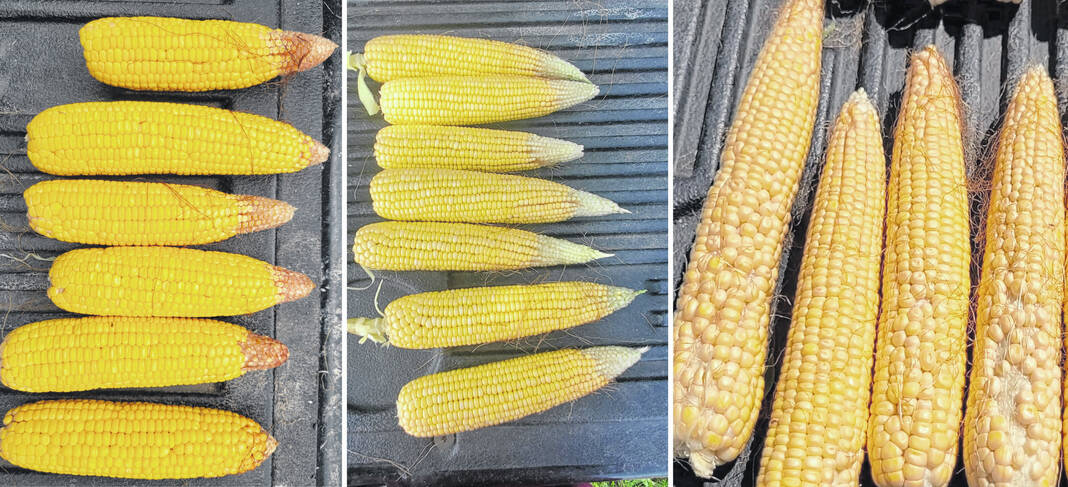

It’s hard to believe that for many of our kids, school is back in session this week or will begin next week. That means the end of August is near and the “dog days” of summer are gone.
That does not mean summer is over. In fact, the calendar says summer ends September 22 — and we will need every day of it and then some to get our crop finished for this year.
Due to the late planting season, many of our crops, not all, will need many more warm days and no threat of an early frost to get the crop to harvest maturity. That was a common discussion point at the recent SW Corn Growers Field Day.
Driving around the county we still have a few cornfields that have not yet tasseled or pollinated (silking stage). My guess is that would be less than 10 percent of the corn acres in Clinton County.
About 55 to 65 days after silking, kernel dry weight usually reaches its maximum and kernels are said to be physiologically mature and safe from frost. Physiological maturity occurs shortly after the kernel milk line disappears and just before the kernel black layer forms at the tip of the kernels.
Not all our corn will be to that point by today. But, if we considered corn was in silk today, and we do the math, we do not want a killing frost before October 23 or 24. For a few fields, it may even mean no killing frost before November 1.
First frosts recorded in our vicinity at the OSU Western Branch in South Charleston, Ohio during 2019-2021 were Oct 18, 2019; Oct 17, 2020; and Nov 11, 2021, respectively. All three years had temperatures between 30 and 32 degrees.
Not killing frosts on those days, but still a recorded frost.
I did some yield checks in corn across the county last week for a statewide report. Corn fields I looked at represented 7 different locations in the county with planting dates of April 27, May 2, May 15-17, and May 27. I won’t divulge any of the yields, but I will tell you they were all below 200 bushel per acre.
Some of the common and not good characteristics found in many of the fields were fewer kernels per row, fewer rows per ear, tip back (missing kernels at the outer end of the ear), sporadic pollination and kernel fill throughout individual ears of corn, significant presence of smut throughout one field, and corn earworm was found in one field.
Some may ask, “Why was there smut present in one field”. We can only speculate, but common smut is often most severe when young tissue is wounded by hail, wind, or mechanical damage. Rainy, wet weather may enhance this disease, as may poor pollination and excessive nitrogen fertilization. Dry or other conditions that interfere with pollination may also favor common smut infection of ears.
The latest planted field was still in late blister stage meaning it had just pollinated and started the kernel fill phase of production.
I recommend you get out into your fields and do some of your own yield check estimates.
Here are instructions — In 4 areas of each field:
Measure off 1/1000th of an acre (17’ 5” for 30 in. rows; 26’ 2” for 20 in. rows)
Count the number of harvestable ears
Sample every fifth ear in the sample row
On every fifth ear, count the number of kernel rows per ear and determine the average
On each of these ears count the number of kernels per row and determine the average (Do not count kernels on either the butt or tip of the ear that are less than half the size of normal size kernels)
Yield (bu/ac) equals: [(ear #) x (avg. row #) x (avg. kernel #)] ÷ 85
(85 represents a “fudge factor” for average kernel depth, can adjust to 80 for excellent kernel depth or 90 for shallow kernel depth).
Remember, this is only an estimate, and you are not evaluating the whole field, just four locations, so by luck of the draw you could be in some poorer areas. That will be a reality in many of our corn fields in 2022 and it will need to be accounted for when estimating yield.
The real proof will be at harvest. Until then, keep hoping for great weather and a late frost.
Tony Nye is the state coordinator for the Ohio State University Extension Small Farm Program and has been an OSU Extension Educator for agriculture and natural resources for over 30 years, currently serving Clinton County and the Miami Valley EERA.



